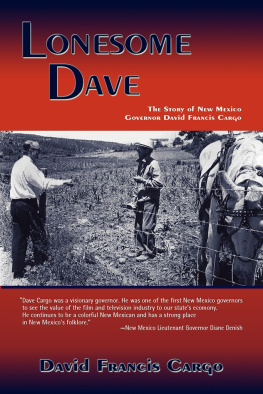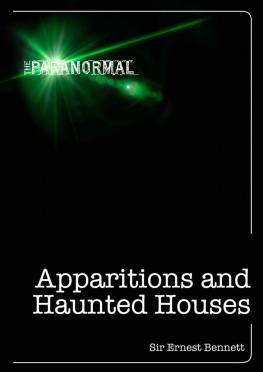Published by Haunted America
A Division of The History Press
Charleston, SC 29403
www.historypress.net
Copyright 2014 by David R. Francis
All rights reserved
Front cover: Hubbard Hall. Authors collection.
First published 2014
e-book edition 2014
ISBN 978.1.62585.141.3
Library of Congress CIP data applied for.
print edition ISBN 978.1.62619.610.0
Notice: The information in this book is true and complete to the best of our knowledge. It is offered without guarantee on the part of the author or The History Press. The author and The History Press disclaim all liability in connection with the use of this book.
All rights reserved. No part of this book may be reproduced or transmitted in any form whatsoever without prior written permission from the publisher except in the case of brief quotations embodied in critical articles and reviews.
FOREWORD
Just up the hill from the busy downtown shops, coffeehouses, restaurants and lively galleries along Maine Street, a small college quietly goes about its business in Brunswick, Maine. This small New England town with a population of around twenty thousand is nestled alongside the Androscoggin River. Tucked away in the remnants of a great pine forest at the top of the hill, Bowdoin College is a highly regarded private liberal arts school widely known for professors who are passionate about teaching and students who bring to life the colleges commitment to the common good. Founded over two hundred years ago, Bowdoin College has a long historynot all of it haunted.
In 1794, Governor Samuel Adams of Massachusetts signed the charter that brought Bowdoin College into existence. Named in honor of James Bowdoin, a prominent leader of anti-British colonial activity and later governor of Massachusetts, Bowdoin College has grown from a school with seven graduates in 1806 to a student body of just under two thousand individuals today. In the years between, Bowdoin has produced a list of prestigious alumni that belies its small size. From writers and Civil War generals to politicians and Olympic gold medalists, the students who have weathered mid-coast Maines long winters and passed through Bowdoins halls have gone on to great achievements. Distinguished literary alumni include Henry Wadsworth Longfellow (1825) and Nathaniel Hawthorne (1825), for whom the largest library on campus is named. Joshua Lawrence Chamberlain (1852) led the Twentieth Maine at Gettysburg during the Civil War and would later serve as governor of Maine and president of his alma mater. And from one of Bowdoins earliest classes to admit women, alumna Joan Benoit Samuelson (1979) earned a gold medal in the first-ever womens Olympic marathon in 1984. This is but a small sampling of the colleges illustrious list of alumni that also includes several U.S. senators, Supreme Court justices and a U.S. president.
A Bowdoin alumna myself, I can personally speak to the unique qualities of the institution that lead to the Bowdoin experience. Academically, Bowdoin challenged me from the start of my first year, and I can remember long, late-night conversations with my two roommates in Coleman Hall about engaging topics from my introductory sociology class. In the arena of athletics, I was on the rugby pitch with Bowdoin women from all over the country. Recreationally, I was spending time with Bowdoins Outing Club and exploring the Atlantic coast via sea kayak. By the end of the spring, the many eye-opening experiences of my first year coalesced into a great enthusiasm for the college. As an admissions campus tour guide during my four years, I had the opportunity to share this enthusiasm with prospective students and their families, hoping to convey in one hour all that Bowdoin offered.
My rewarding student experience at Bowdoin led me to pursue a career in higher education administration, and in my first job after graduating, in the Office of Residential Life at Bowdoin, I met David Francis, who was a fellow tour guide (though I did not know that at the time). As a colleague, David was invaluable; he was the IT architect behind many of the systems that we relied on to do our work in residential life. A man who is quick to smile and has a sharp sense of humor, he was never dull to work with.
It was through Lisa Rendall, a colleague in my office, that I first heard about Davids Haunted Tour. Informally, David had invited a small number of us to join him one evening after work to explore the spookier side of campus. It was late October in Maine, where the sun sets before six oclock, when the tour group gathered in the fading daylight. Everyone was bundled up in warm coats as we roamed the quad, and David shared with us the mysterious history of campus buildings. Adams Hall stands out for me (as it probably does for most people) as the most memorable stop on the Haunted Tour. He took us down into the creepy basement, where the cadavers awaiting dissection had been stored when the medical college was located there. He directed our attention to the top of the buildings staircase so we could see the hook that was used to hoist the cadavers to the top floor for dissection. I had been in Adams Hall many times as a student and must admit I was shocked to think how I passed that spot for years without thinking twice about the hook jutting out of the ceiling.
The conclusion of the tour was at Annas grave. Throughout the tour, David had been alluding to a grave on campus. I was understandably skeptical, as I had spent a great deal of time on campus and felt that if such a thing existed, I would have noticed it. But outside one of the red brick first-year residence halls, he brought to my attention a light gray square inscribed with the name Anna. With his typical flair and encouragement for participation, he asked for guesses of what was buried at this spot. After the incorrect guesses of a student and a beloved pet, we were treated to the full story, which I wont spoil for you, but I assure you it is revealed in one of the later chapters.
The darkness of night had settled as we parted ways at the end of the tour, and I was left thinking about all the secrets of the Bowdoin College campus. I had been a tour guide, lived on campus for years and thought I knew it well, but in this one evening, I had learned many stories new to mestories I might never have known otherwise. Knowing firsthand how these stories can enrich ones appreciation for the college, it came as no surprise to me that the enthusiasm for Haunted Bowdoin tours has continued to grow over the years and that Davids collection of historical and personal accounts of the spookier side of campus has multiplied.
I can think of no better guide for a Haunted Bowdoin tour. Davids enthusiasm for Halloween and spooky stories is reflected in his annual tradition of decorating his home. Each October, his home always draws attention for being the best decorated on the street. There are spider webs in the windows and alarming motion-activated devices to scare passersby. So while not all of us are fortunate enough to join one of Davids tours on a chilly October evening, I am thrilled he has created this work as a resource to those who like to brush aside spider webs and hunt for the spookier history that is lurking on Bowdoins campus.
Erica Ostermann, 06
Assistant Dean
Cornell University
Ithaca, New York










